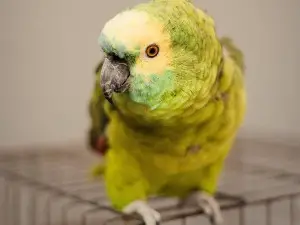
Humans are known to grey as we get older, this is because our hair follicles produce less color as we age, but why do birds start developing grey feathers?
This article looks into why this may be happening to your bird
Table of Contents
Why are my bird’s feathers turning grey?
Some birds have a set of grey feathers, or some grey on their feathers, naturally, but this isn’t the case for all birds.
If your bird’s feathers aren’t normally grey, and the bird starts to produce some grey feathers you’d be right to be confused.
Here is why this may be happening with your bird:
Molting:
Molting is a phenomenon where birds shed their old feathers to make room for the growth of new feathers.
Many animals have to remove the old layer of skin, hair, or fur from their bodies sometime, birds included.
Birds can molt once or twice a year and by the time the feathers are ready to molt they are likely quite raggedy and worn out, the feathers during this stage have likely also lost a lot of their bright vibrancy and have turned duller even looking grey, ashy or even white.
What to do:
Molting is normal and natural for birds, feathers looking tattered and grey during molting is quite normal and is nothing to worry about.
Unfortunately, there isn’t anything that you can do to get the bird’s feathers back to being vibrant, the bird will simply have to shed these feathers.
You can help the next feathers grow vibrant by making sure to feed your bird a nutrient-rich diet during the molt and during the feather regrowth phase.
You can also make the molt more comfortable for the bird by moisturizing the bird’s skin during this time as molting is irritating to the bird’s skin.
Do this by misting the bird or using a humidifier in the bird’s room to keep the bird’s environment humid
Also, avoid petting or handling the bird during this time as this will be uncomfortable to the bird because of its irritated skin.
Parrot dust:
If you’re raising a parrot, and its feathers are starting to look grey, then the bird may be collecting too much parrot dust.
Parrots produce a dust that is usually white, this dust can also be grey in color.
This dust keeps your bird’s feathers soft and silky but too much can stick to the bird if the bird does not bathe as often as it needs to.
You’ll be able to better see this dust in the air when the bird is preening, flapping its wings, or playing.
Parrots need to be bathed several times a week in order to remove the parrot dust from their feathers. If the birds do not bathe often enough then the bird’s feathers may start to look dull or grey.
What to do:
You can quickly and easily remedy this issue by making sure that the bird has the opportunity to bathe a few times a week.
The bird will know how often it needs to bathe in order to keep itself clean, simply offer the bird a small bowl of water to clean itself with and it will do the rest.
Water alone is enough to get rid of the dust, you don’t have to add any soap or anything else to the water.
Lack of light:
Birds need sunlight to synthesize vitamin D3 and maintain a vibrant array of feathers. If your bird isn’t getting enough time in the sun then its once bright and beautiful feathers may start to look grey.
What to do:
You can remedy this by simply getting your bird out in the sun for longer and waiting to see if the bird’s feathers improve.
If you enjoyed this article then you may also be interested in other bird related articles. Here are some articles that you may be interested in: Budgie Cere Hypertrophy, Budgie Cere Overgrowth, Why Is My Budgie’s Beak Dry?, How To Tell If Birds Are Bonded To Each Other, How To Know If A Parrot Is Angry, Cockatiel Growth On Side Of Beak, Black Feather Fungus, Black Spots On Cockatiel Feathers, Conure Feathers Turning Black

